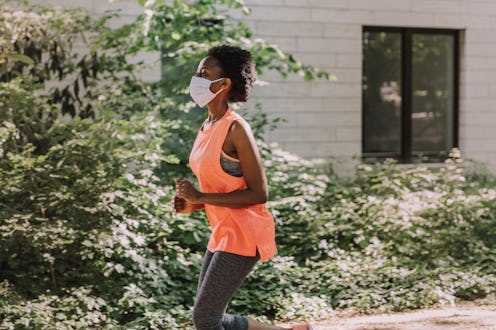Health
Here’s What Kind Of Face Masks Work & Which Ones Don’t
A new study showed how effective your DIY masks are.

By now, you’ve amassed a collection of masks to go with every outfit in your WFH arsenal, and probably have a designated key hook for your favorite one. (Yes, it’s tie-dye, and yes, you bought it off an Instagram ad.) Because they’re one of the simplest, effective ways to stop the spread of coronavirus, you have your water-resistant mask for running, your linen one for socially distant hangs, and your one surgical mask, just in case. But which types of face masks are the most effective against coronavirus?
A study published online in September in the journal Science Advances sheds some light on the topic. Duke University researchers looked at 14 different kinds of masks, from N95s, to homemade cloth masks, to those neck gaiters your dad probably wears for fishing. A volunteer said a simple phrase — “stay healthy, people” — while wearing each mask, while a laser beam illuminated the respiratory droplets that came through the face covering. An iPhone caught the experiment on tape, and the researchers used a computer algorithm to count the droplets.
N95 respirators without valves let out the least amount of droplets, while neck gaiters actually spread more droplets than if the person hadn’t been wearing a mask in the first place, likely because the fabric broke up normal droplets into smaller ones. “Considering that smaller particles are airborne longer than large droplets (larger droplets sink faster), the use of such a mask might be counterproductive,” the authors wrote in the study. Coronavirus spreads via exposure to infected droplets, which are what come out whenever you breathe, cough or sneeze, or talk, and droplets in aerosolized form, which are much smaller and can hang around in the air for up to a few hours.
Bandanas tied around the nose were found to be a little better than neck gaiters, but not very protective compared to cloth masks, especially cloth masks with multiple layers of fabric or filters. After N95s, which are typically reserved for health care workers, disposable surgical masks came in as the next-most effective.
The researchers set out to analyze the technique by which they measured droplet transmission, not the droplet transmission itself, but the findings are still useful, given how quickly the science on coronavirus is evolving. The study authors noted that the study wasn’t comprehensive of all possible mask designs, and was limited in scope: The masks were tested by up to five speakers, but some evidence has shown that speech volume can affect how far respiratory droplets go, which can in turn affect how many infections result.
A small study in Scientific Reports of 10 participants who spoke or coughed while wearing different masks replicated these results. N95 and disposable medical masks were the most effective masks for preventing the spread of droplets, blocking up to 90% of them. Homemade masks were effective, too, but the scientists found that they produce a bunch of particles made of tiny parts of fabric when you breathe or talk. It's not clear from the study whether those particles might carry coronavirus, but the scientists behind it say it's a signal that you need to clean your homemade masks after every use.
Wondering about the best fabric choice for your mask-making workshop? Another study published in Extreme Mechanics Letters looked at the materials of homemade masks, and it turns out that whatever you choose, DIY mask-making is probably pretty effective. The researchers tested 11 fabrics that could be repurposed as masks, including cotton T-shirts, bedsheets, and dishcloths. They found that every one of the fabrics was effective at blocking droplets of the same size as coronavirus particles. Even more permeable fabrics, like old T-shirts, become really effective when used in two or three layers at a time. If in doubt, add multiple layers to your mask-making.
As long as you're wearing a mask that's designed to actually be a mask, not just something that covers your nose and mouth, it’s helpful to keep coronavirus from spreading (and in some cases, protect you from being infected, too). Use multiple layers for your DIY mask, wash it regularly, and throw it away when the fabric starts to get grody, and science says you're doing all the right things. While more research needs to be done to standardize what masks work best, when, these findings should give some peace of mind.
Studies cited:
Asadi, S., Cappa, C.D., Barreda, S. et al. (2020) Efficacy of masks and face coverings in controlling outward aerosol particle emission from expiratory activities. Sci Rep10, 15665. https://doi.org/10.1038/s41598-020-72798-7
Aydin, O., Emon, B., Cheng, S., Hong, L., Chamorro, L. P., & Saif, M. (2020). Performance of fabrics for home-made masks against the spread of COVID-19 through droplets: A quantitative mechanistic study. Extreme Mechanics Letters, 40, 100924. https://doi.org/10.1016/j.eml.2020.100924
Fischer, E. P., Fischer, M. C., Grass, D., Henrion, I., Warren, W. S., & Westman, E. (2020). Low-cost measurement of face mask efficacy for filtering expelled droplets during speech. Science advances, 6(36), eabd3083. https://doi.org/10.1126/sciadv.abd3083
This article was originally published on